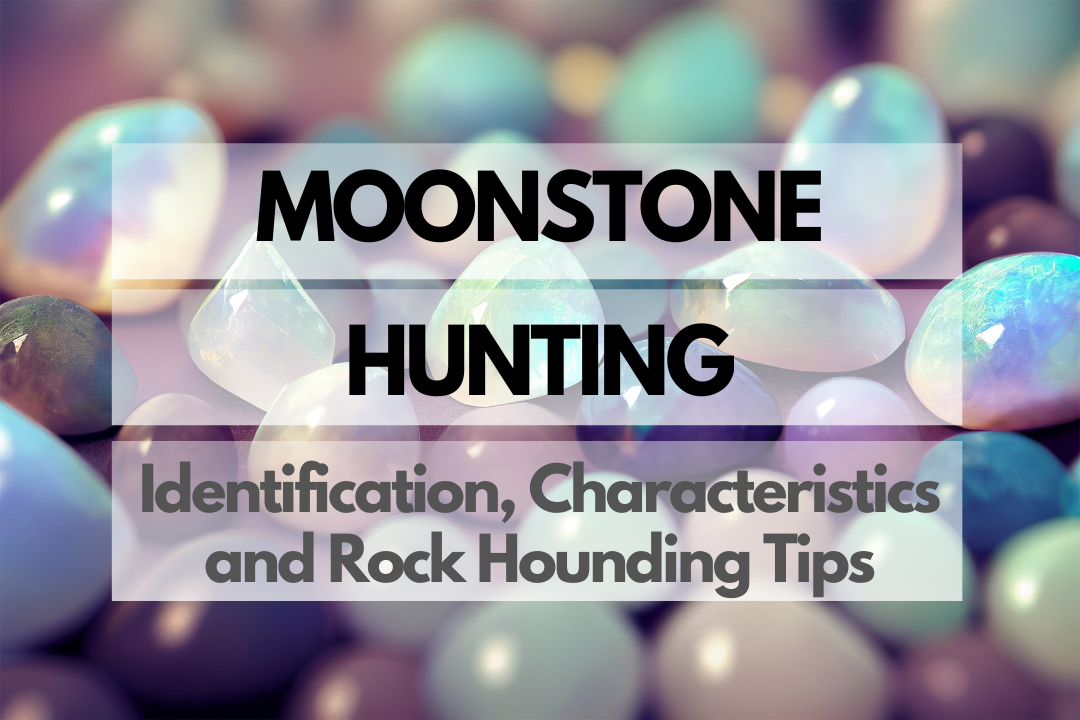Embarking on a moonstone hunting adventure is a thrilling experience. With its enchanting appearance and fascinating history, moonstone appeals to rock hounds and gem enthusiasts alike. In this article, we will explore the history, identification, characteristics, and various uses of this captivating gemstone.
History & Origin of Moonstone
Moonstone has captivated cultures around the world for centuries. Known for its mysterious, shimmering appearance, moonstone is a variety of the mineral feldspar. The name “moonstone” was coined by the ancient Romans, who believed the gemstone was formed from solidified moonlight. Various cultures have attributed spiritual and healing properties to moonstone, associating it with lunar deities, fertility, and protection.
Moonstone Identification & Physical Properties
Identifying moonstone is relatively easy thanks to its unique physical properties. The table below provides an overview of these properties:
| Property | Description |
|---|---|
| Chemical formula | KAlSi3O8 (potassium aluminum silicate) |
| Crystal system | Monoclinic |
| Color | Colorless, white, gray, peach, yellow, green, blue, brown |
| Luster | Pearly, vitreous |
| Transparency | Transparent to translucent |
| Hardness (Mohs) | 6-6.5 |
| Cleavage | Perfect in one direction |
| Fracture | Uneven to conchoidal |
Moonstone Colors
Moonstones exhibit a wide range of colors, including colorless, white, gray, peach, yellow, green, blue, and brown. The most highly prized moonstones are those with a strong blue sheen, known as “blue flash” or “blue adularescence.”
Moonstone Hardness
Moonstone has a hardness of 6 to 6.5 on the Mohs scale, making it a relatively soft gemstone. Due to its delicate nature, moonstone should be handled with care to avoid scratching or chipping.
Moonstone Types
Rainbow Moonstone
Rainbow moonstone, often confused with true moonstone, is a variety of labradorite that displays a multicolored adularescence. This stunning gemstone is highly sought after for its captivating play of colors.
Blue Moonstone
Blue moonstone, also known as “blue sheen moonstone,” is the most valuable type of moonstone. It exhibits a strong blue flash, with colorless to white body color. The more transparent and intense the blue flash, the more valuable the gemstone.
White Moonstone
White moonstone is the most common type of moonstone, displaying a pearly white sheen. While not as highly valued as blue moonstone, white moonstone is still a popular choice for jewelry and decorative pieces.
Gray Moonstone
Gray moonstone, sometimes called “silver moonstone,” exhibits a silvery-gray sheen. It is less common than white moonstone and is often used in jewelry for its unique, subdued appearance.
Moonstone Uses
Moonstone has a variety of uses, including:
- Jewelry – Moonstone is often used in rings, necklaces, bracelets, and earrings.
- Carvings and decorative pieces – Moonstone’s alluring appearance makes it a popular choice for carvings and ornamental objects.
- Amulets and talismans – Due to its historical associations with spirituality and protection, moonstone is sometimes used in amulets and talismans.
HowMuch Is Moonstone Worth?
The value of moonstone varies greatly depending on factors such as color, clarity, size, and origin. Generally, the price range for moonstone is from $10 to $500 per carat. Blue moonstone with a strong adularescence is typically the most valuable, while white and gray moonstones are more affordable. Rainbow moonstone, while not a true moonstone, can also fetch high prices due to its stunning display of colors.
Moonstone Rock Hounding Tips
Embarking on a moonstone hunting adventure? Follow these tips and tricks to ensure a successful, enjoyable, and safe experience!
Essential Tools and Equipment
- Rock hammer or geologist’s hammer for breaking and chipping rocks
- Chisel to separate specimens from surrounding rock
- Hand lens or magnifying glass for close examination
- Sturdy gloves to protect your hands from sharp edges
- Sturdy shoes or boots for navigating rough terrain
- Backpack or collecting bag to carry your finds
- Notebook and pen for documenting your discoveries
- GPS device or smartphone app to mark locations
Safety Tips
- Always wear safety goggles to protect your eyes from flying rock fragments.
- Wear long sleeves and pants to protect your skin from cuts and scratches.
- Carry a first aid kit in case of minor injuries.
- Bring plenty of water and snacks to stay hydrated and energized.
- Always inform someone of your plans and expected return time.
- Be aware of your surroundings and watch for potential hazards such as falling rocks, wildlife, or unstable terrain.
Moonstone Hunting: Where to Find Moonstone
Moonstone can be found in various countries around the world. Some of the best places to search for moonstone are Sri Lanka, India, Madagascar, and the United States. Check out the table below for specific locations to find this enchanting gemstone:
| Site/Area | Location |
|---|---|
| Ratnapura | Sri Lanka |
| Andhra Pradesh | India |
| Ambatondrazaka | Madagascar |
| Mount Ida | Arkansas, United States |
Caring For Your Moonstone
To keep your moonstone specimens in beautiful condition, follow these basic care tips:
- Handle with care, as moonstone can be fragile and susceptible to scratches.
- When cleaning, use a soft brush and mild soap to gently remove dirt and debris. Rinse with water and pat dry with a soft cloth.
- Store specimens in a padded box or display case to protect them from damage.
- Keep moonstone away from direct sunlight, high temperatures, and harsh chemicals, as this can cause fading or damage.
Additional Resources
- Mindat.org – Moonstone information
- United States Geological Survey (USGS)
- Rockhounds.com – Online community for rock enthusiasts
- American Federation of Mineralogical Societies
- A Text-Book of Precious Stones by Frank Bertram Wade
Additional Moonstone FAQs
What are the benefits of Moonstone?
Moonstone is prized for its beauty, unique adularescence, and versatility, making it popular among rock collectors, lapidary artists, and jewelry makers. Its captivating appearance and rarity have also made moonstone a sought-after gemstone throughout history.
Do Moonstone have any healing properties?
While there is no scientific evidence to support the idea of healing properties in moonstone, some people believe that this stone can provide emotional balance, enhance intuition, and promote restful sleep. These claims are based on cultural beliefs and personal experiences, rather than empirical data.
Do Moonstone have any spiritual meaning?
In various culturesand spiritual practices, moonstone has been associated with the moon, fertility, love, and protection. It is believed to help attune the wearer to the natural cycles of life and promote a deeper connection with one’s intuition and emotional self.
Do I need a permit to go Moonstone hunting?
Permit requirements for rock and mineral collecting vary depending on the location and land ownership. In the United States, you may need a permit for collecting on certain public lands, such as national forests or Bureau of Land Management (BLM) areas. Always check with the appropriate land management agency before collecting. For more information about permits and regulations in the United States, visit the BLM Rockhounding page or consult the local U.S. Forest Service office.
Closing Thoughts
Now that you’re equipped with essential tips, tools, and locations, it’s time to embark on your moonstone hunting adventure! Remember to prioritize safety, respect the environment, and follow local regulations. Whether you’re a seasoned rockhound or a beginner, the thrill of discovering a beautiful moonstone specimen is an experience you’ll treasure for years to come. Happy rockhounding!

